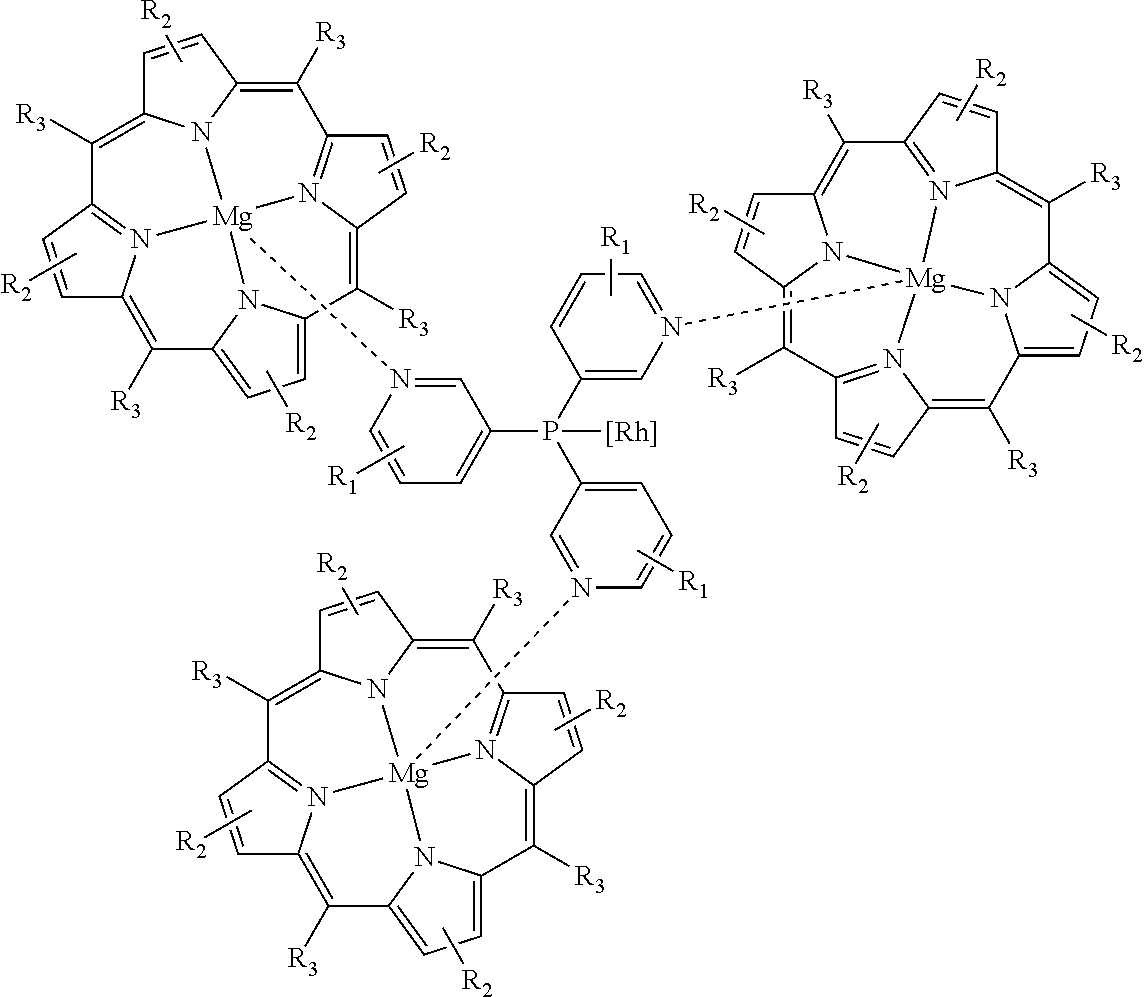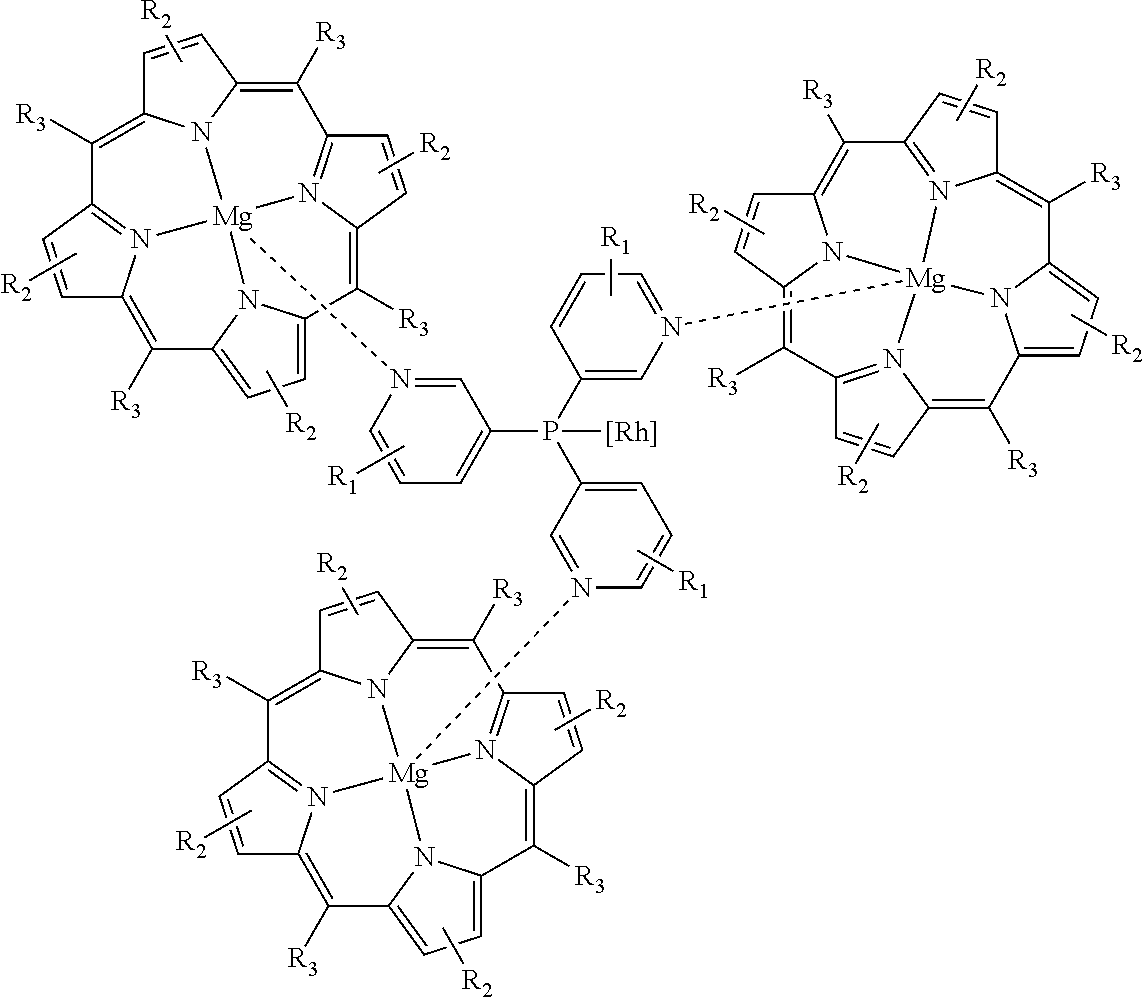Catalysts and process for producing aldehydes
a technology of catalysts and aldehydes, applied in the direction of catalyst activation/preparation, physical/chemical process catalysts, organic compounds/hydrides/coordination complexes, etc., can solve the problems of unprecedented challenges in the global iso-butyraldehyde production, and the selective hydroformylation at the c2 carbon position of these olefin substrates is quite challenging
- Summary
- Abstract
- Description
- Claims
- Application Information
AI Technical Summary
Benefits of technology
Problems solved by technology
Method used
Image
Examples
example 1
Effect of Using a Magnesium Porphyrin Complex with the Tris(3-Pyridyl)Phosphine Rhodium System at 19° C. with 1-Octene as Substrate
[0031]The hydroformylation reaction in this example was carried out by first dissolving Rh(acac)(CO)2 (7.6 mg, 0.03 mmol) in toluene (45 mL) followed by addition of tris(3-pyridyl)phosphine (17.5 mg, 0.066 mmol) then addition of the tetraphenylporphyrin magnesium complex (125 mg, 0.2 mmol). The solution was then degassed by argon bubbling followed by addition of 1-octene (1.37 g, 12.2 mmol) and a decane internal standard, both via syringe. The solution was then charged to an autoclave which was then pressurized and vented three times with nitrogen. Stirring was set to 1,000 rpm, the reactor temperature maintained at 19° C. and 21.7 bara (300 psig) of a 1:1 CO:H2 gas mixture added. After eighteen hours, the autoclave was vented and the product analyzed by gas chromatography. The results are summarized in Table 1.
[0032]This example demonstrates that the ma...
examples 2 to 6
Effect of Using Other Metal Porphyrin Complexes with the Tris(3-Pyridyl)Phosphine Rhodium System at 19° C. with 1-Octene as Substrate
[0033]These Examples were carried out as described in Example 1 except that different metal porphyrin complexes were used; the results are summarized in Table 1. Consistent with the prior art, the zinc porphyrin system affords an N:I ratio of 0.61 (62% iso-aldehyde). Other porphyrin metal complexes, however, have undesirable and unpredictable effects on the N:I selectivity.
[0034]
TABLE 1Press.TimeTemp.Example(bara)(h)(° C.)SubstrateMS / RhL / RhTPP / LConv.N:Iiso-Isom.Ex. 121.718191-OcteneMg4152.23.063%0.3574%0%Ex. 221.718191-OcteneZn3772.12.998%0.6162%0%Ex. 321.718191-OcteneV(O)4152.12.940%3.025%0%Ex. 421.718191-OcteneCo4082.42.763%1.0150%0%Ex. 521.718191-OcteneCu3922.42.644%2.9425%0%Ex. 621.718191-OcteneNi4042.25.541%2.9835%0%
examples 7 and 8
Effect of Using a Metal Porphyrin Complex with the Tris(3-Pyridyl)Phosphine Rhodium System at 80° C. with 1-Octene as Substrate
[0035]The hydroformylation reactions in these examples were carried out as described in Example 1 except that the autoclave was heated to 80° C. prior to the pressurization step. After one hour, the autoclave was vented then cooled and the product analyzed by gas chromatography. The results are summarized in Table 2. These examples demonstrate that both the TPP-zinc and TPP-magnesium systems provide an N:I ratio between 1.5 and 1.6 at 80° C. (˜40% iso-aldehyde). This confirms that the magnesium system is at least as effective as the zinc at elevated temperature. Indeed, as reported previously, the N:I selectivity under these conditions is about 3.0 when the hydroformylation is performed in the absence of a porphyrin complex.
[0036]
TABLE 2Press.TimeTemp.Example(bara)(h)(° C.)SubstrateMS / RhL / RhTPP / LConv.N:Iiso-Isom.Ex. 721.71801-OcteneMg3832.03.399%1.5240%8%Ex....
PUM
| Property | Measurement | Unit |
|---|---|---|
| mole ratio | aaaaa | aaaaa |
| pressure | aaaaa | aaaaa |
| mole ratio | aaaaa | aaaaa |
Abstract
Description
Claims
Application Information
 Login to View More
Login to View More - R&D
- Intellectual Property
- Life Sciences
- Materials
- Tech Scout
- Unparalleled Data Quality
- Higher Quality Content
- 60% Fewer Hallucinations
Browse by: Latest US Patents, China's latest patents, Technical Efficacy Thesaurus, Application Domain, Technology Topic, Popular Technical Reports.
© 2025 PatSnap. All rights reserved.Legal|Privacy policy|Modern Slavery Act Transparency Statement|Sitemap|About US| Contact US: help@patsnap.com



